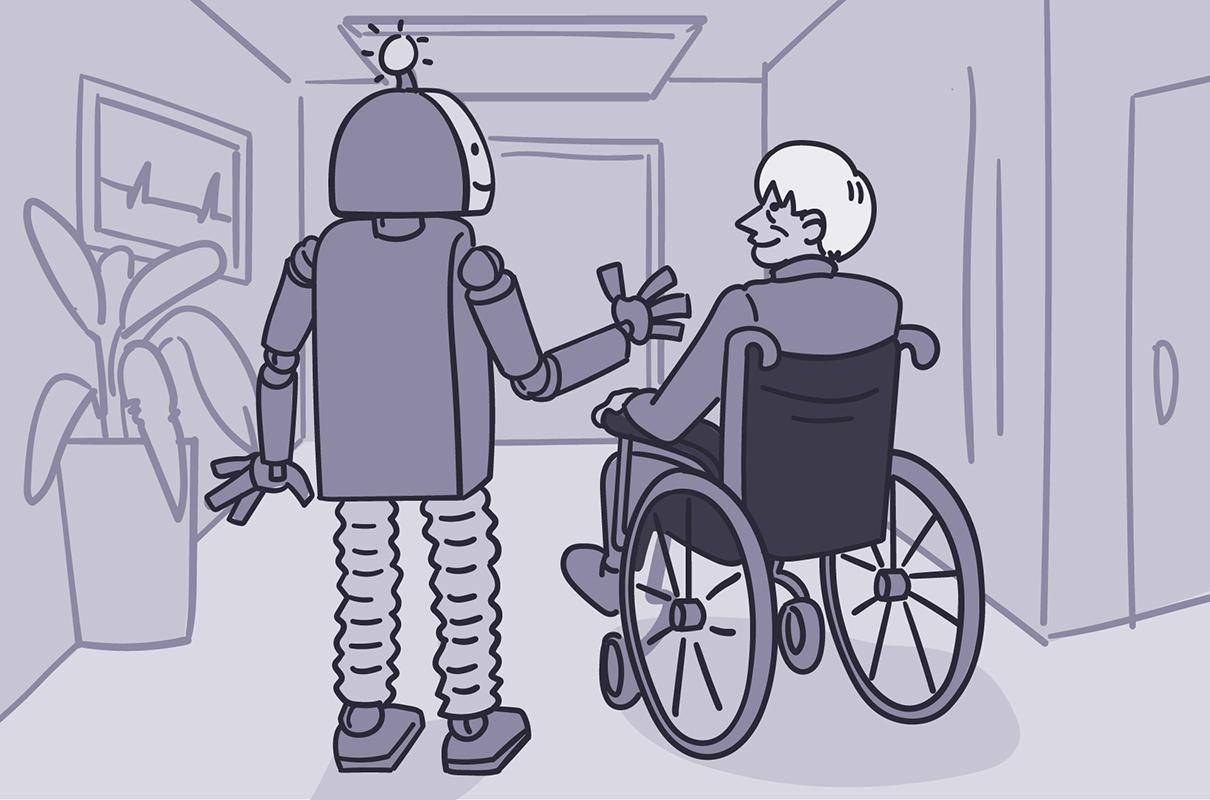Medical Robots to the Rescue
New Technologies to Help Our Health

What do you think of when you hear the word robot? Is it a human-like assistant with a friendly face, or a large and menacing foe? Generally, a robot is a machine that that’s been built to perform specific tasks.
“When most people hear the term ‘robot,’ they think of things made of solid metal and electronics,” says Dr. Ryan Sochol, a mechanical engineer at the University of Maryland. But medical robots can come in many shapes and sizes.
Sochol and his colleagues are creating tiny flexible robots to improve surgical techniques. Other scientists are developing wearable robots to enhance mobility. And others are creating and testing human-like social robots. These may be able to provide information and improve well-being.
Most of these robotic devices are still in the research and development phase. They’re not yet ready for general use. But some may become available within the next five to ten years.
Robots usually have three key features. They have a sensor that can detect things—like light, motion, heat, or sound. They have an “actuator” that converts energy into movement. And they have a control system or computer program that directs the robot’s activities. Many robots today also depend on artificial intelligence (AI) to assess large amounts of data.
“Robots are everywhere. Even many cars now have robots,” says Dr. Xiaopeng Zhao, a biomedical engineer at the University of Tennessee, Knoxville. These systems can help drivers with parking, staying within lanes, or cruise control. “And with the support of AI technology, robots will become more useful and more powerful.”
Social Robots Help Out
Zhao and others are studying how human-like, interactive robots could help people with dementia and their caregivers. As the U.S. population ages, there’s a growing need for caregivers. Family caregivers often provide countless hours of support. That can lead to a lot of stress.
Zhao and his team interviewed patients and caregivers at assisted living facilities, senior centers, and memory clinics. They asked about their needs and challenges. They then customized a four-foot tall, human-like robot. It has a touch screen on its chest. These AI-powered robots can listen, talk, move, play videos, and dance. They can also encourage people to reminisce about earlier experiences.
“Patients with Alzheimer’s can have short-term memory loss,” Zhao says. “But they may be able to recall what happened 20 or 30 years ago.”
The robots can play old songs, discuss sports, or ask questions to trigger memories.
“Reminiscing may not restore memory, but it can improve emotional well-being and quality of life,” Zhao says. Robots can patiently listen to the same stories over and over.
Zhao’s group is also developing robots that can assist caregivers by providing evidence-based information about dementia. The robots can give tips to help caregivers reduce their own stress and stay healthy.
Robots for Surgery
Other researchers have been developing tiny robotic tools to help surgeons and physicians. Robotic surgery can lead to less pain and blood loss, smaller scars, and quicker recovery. It can have fewer complications compared to traditional surgery.
Robotic surgeries usually involve making little openings through the skin and then inserting small 3D cameras and surgical tools. Sochol’s team is developing miniature tools and robotic techniques to assist with complex surgeries. They’re creating soft robotic devices, made of flexible or compliant materials. These flexible gadgets are helping to improve a type of brain surgery for weakened and bulging blood vessels, called aneurysms.
Minimally invasive aneurysm surgery typically involves threading a thin plastic tube, or microcatheter, through the body to reach the brain. The weakened blood vessel can then be repaired or sealed. But the microcatheter has to make many twists and turns along the way, and it can be hard to maneuver. If the catheter can’t reach the aneurysm, the surgery must be canceled.
Sochol and his team used 3D printing to create microcatheters that surgeons can steer to reach these tricky parts of the brain. “We created a soft robotic microcatheter that can bend on demand during the procedure to help surgeons reach those hard-to-access areas,” he says.
Other NIH-supported scientists are developing soft robotic techniques to improve heart surgery, bowel surgery, and lung biopsies. These soft robotic tools are still
considered experimental.
Wearable Robotics
NIH also funds studies to develop artificial limbs, or prosthetic devices, to replace lost or damaged body parts. Some of these robotic devices connect to the brain and let people control movement of artificial hands, legs, and other limbs.
Other researchers are developing battery-powered exoskeletons to help move existing limbs. “Exoskeletons are robots that you wear on your body. They can fit on top of your limbs, kind of like clothing. You can put them on and take them off, like boots or pants,” says Dr. Gregory Sawicki, a biomedical engineer at the Georgia Institute of Technology. “They can work in synch with your muscles, so your muscles don’t have to do all the work.”
Sawicki and his colleagues have been studying how exoskeletons might help improve mobility and prevent falls as people age. Falls can lead to fractures, hospitalization, and disability in older adults. “A primary reason why people fall is that their body can’t react fast enough,” Sawicki says. Robots have the potential to respond more quickly to balance problems than the human body can. Researchers are working to develop more comfortable and lightweight exoskeletons that seem more like clothing.
“To live long happy lives, we’ve got to be mobile for as long as possible. Mobility helps us have social connections, which are incredibly important as we age,” Sawicki says. “These kinds of mobility assistive technologies can help us move farther on less energy and to interact with people.”
Robots can make life easier or better in many ways. But they’re no substitute for human interactions.
“It’s clear that many tasks can be done by robots. They’re especially helpful with repetitive or tedious tasks,” Zhao adds. “But when we’re talking about love, empathy, and bonding between humans, these qualities remain uniquely human.”
NIH Office of Communications and Public Liaison
Health and Science Publications Branch
Building 31, Room 5B52
Bethesda, MD 20892-2094
Contact Us:
nihnewsinhealth@od.nih.gov
Phone: 301-451-8224
Share Our Materials: Reprint our articles and illustrations in your own publication. Our material is not copyrighted. Please acknowledge NIH News in Health as the source and send us a copy.
For more consumer health news and information, visit health.nih.gov.
For wellness toolkits, visit www.nih.gov/wellnesstoolkits.




